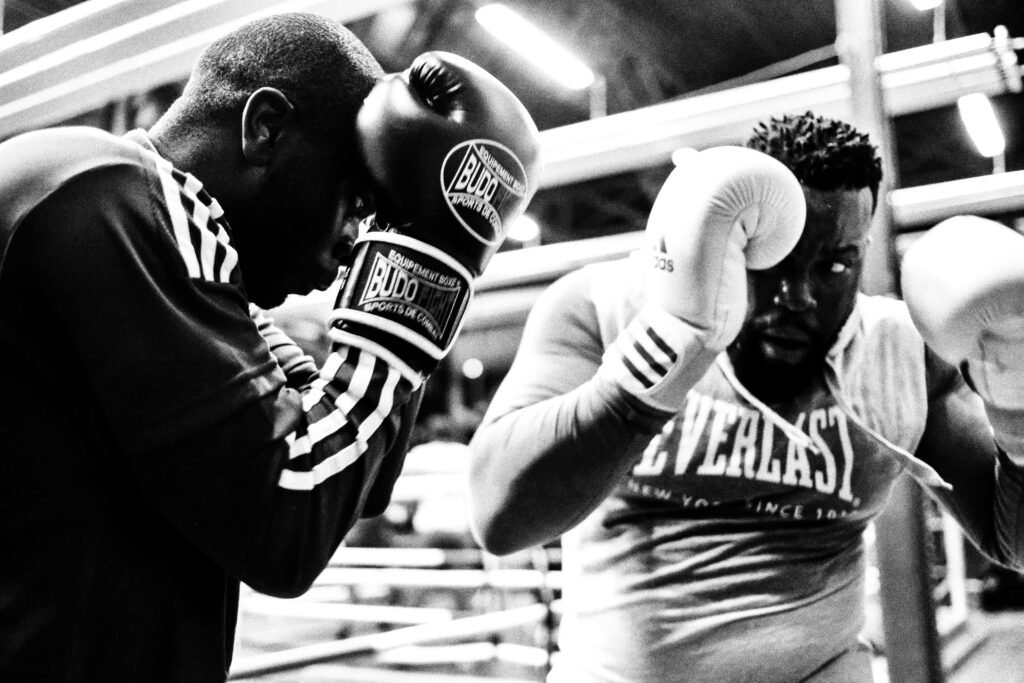Seven In-Depth Strategies to Elevate Your Boxing Defense
A strong defense not only safeguards you from harm but also sets the stage for potent counterattacks. Let’s dive deeper into seven strategies that will help you master the art of boxing defense!
1. Master the Basics: Stance and Guard
Your journey toward a rock-solid defense starts with your stance and guard. A proper boxing stance entails:
- Feet Shoulder-Width Apart: Maintain balance by positioning your feet shoulder-width apart.
- Knees Slightly Bent: Slightly bend your knees to lower your center of gravity and enhance agility.
- Weight Distribution: Distribute your weight evenly between both feet for balance.
- Guard Up: Protect your chin and vital areas with your gloves while keeping your guard up.
- Peripheral Vision: Ensure you maintain peripheral vision to monitor your opponent’s movements.
Drill: Practice your stance in front of a mirror. Focus on balance and maintaining your guard while moving around.
2. Head Movement: Slip, Bob, and Weave
Effective head movement is your second line of defense. These techniques minimize the impact of incoming punches:
- Slipping: Move your head to the outside of an opponent’s punch, causing it to miss.
- Bobbing: Use subtle torso movements to duck under punches.
- Weaving: Incorporate both head and torso movements to evade punches.
Drill: Partner with a friend or coach who throws jabs and crosses at varying speeds. Practice slipping, bobbing, and weaving in response.
3. Footwork: Step In, Step Out
Footwork is your defensive foundation. Develop agility, balance, and control through these techniques:
- Stepping In: Move closer to your opponent to smother their attacks.
- Stepping Out: Retreat from your opponent’s range to avoid incoming punches.
- Pivoting: Rotate your lead foot to change angles and create openings or evade attacks.
- Circling: Move around your opponent to disrupt their positioning.
Drill: Set up cones or markers and practice stepping in, stepping out, pivoting, and circling around them to simulate real fight scenarios.
4. Practice Blocking and Parrying
Blocking and parrying are crucial components of your defense. Execute these techniques effectively:
- Blocking: Use your gloves to cover your head and body, reducing the impact of incoming punches.
- Parrying: Redirect your opponent’s punches away from your centerline, nullifying their effectiveness.
Drill: Have a partner throw various punches at you. Focus on blocking and parrying while maintaining a stable guard.
5. Sparring and Defensive Drills: Realistic Training
Engaging in sparring sessions and specific defensive drills with a partner is invaluable:
- Reaction Drills: Work on reacting to specific punches and counters.
- Focus Mitt Drills: Improve precision and timing with a partner holding focus mitts.
- Body Pad Drills: Train your defense against body shots.
- Defense Under Pressure: Spar with a partner, focusing on defense rather than offense.
Drill: Spar with a partner, with one of you primarily on the defensive, working on slipping, blocking, and countering effectively.
6. Develop High Fitness Levels
Physical conditioning is an often-overlooked aspect of defense. High fitness levels contribute to your defense by:
- Maintaining Stamina: Good cardiovascular fitness ensures you can maintain your defensive movements throughout a fight.
- Enhancing Stability: Strong muscles provide stability and control when defending against an opponent’s attacks.
Drill: Include cardiovascular workouts and strength training in your regular training regimen to enhance your overall fitness.
7. Study Opponents and Boxing Styles
Understanding your opponents and various boxing styles gives you a tactical edge:
- Analyze Opponents: Study your adversaries, noting their tendencies, habits, and weaknesses.
- Anticipate Movements: Anticipate your opponent’s punches and movements based on your analysis.
- Exploit Openings: Use your defensive skills to exploit openings in your opponent’s guard.
Drill: Watch videos of your potential opponents, analyze their fights, and practice your defensive strategies based on your observations.
Summary
Mastering the art of boxing defense is an ongoing journey. By figuring out the nuances of your stance and guard, perfecting head movement, refining footwork, and mastering blocking and parrying, you create a solid foundation.
Engage in sparring sessions and specific drills to develop practical defensive skills under real fight conditions. High fitness levels and a thorough understanding of your opponents and boxing styles enhance your overall defense, leaving you to be an exceptional defense fighter!

